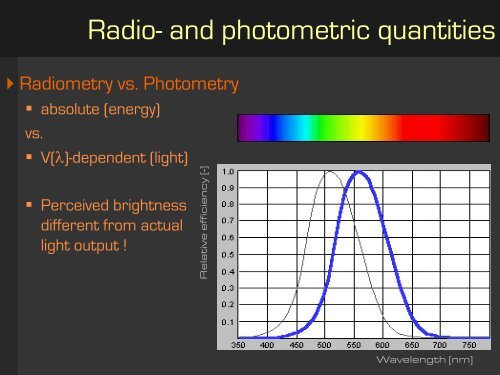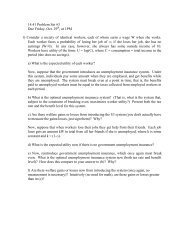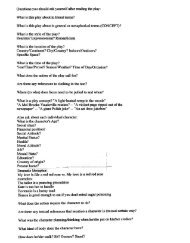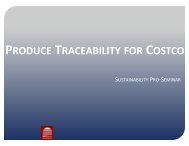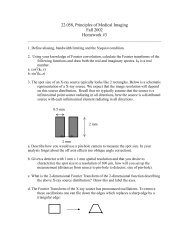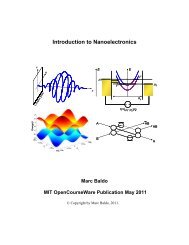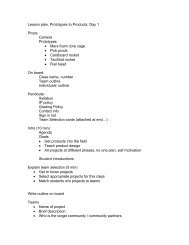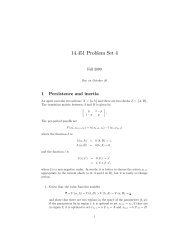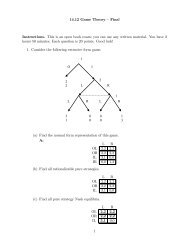Radio- and photometric quantities
Lecture (2).pdf
Lecture (2).pdf
- No tags were found...
You also want an ePaper? Increase the reach of your titles
YUMPU automatically turns print PDFs into web optimized ePapers that Google loves.
<strong>Radio</strong>- <strong>and</strong> <strong>photometric</strong> <strong>quantities</strong><br />
Flux<br />
Illuminance<br />
• flux received / unit of surface<br />
• E in [W/m 2 ] vs. [lm/m 2 ] or lux [lx]<br />
∆φ<br />
∆S<br />
Figure by MIT OCW.
<strong>Radio</strong>- <strong>and</strong> <strong>photometric</strong> <strong>quantities</strong><br />
Flux<br />
Illuminance<br />
• flux received / unit of surface<br />
• E in [W/m 2 ] vs. [lm/m 2 ] or lux [lx]<br />
Full moon<br />
Overcast sky<br />
Sunlight<br />
0.01 lux<br />
8’000 - 20’000 lux<br />
100’000 lux
<strong>Radio</strong>- <strong>and</strong> <strong>photometric</strong> <strong>quantities</strong><br />
Flux<br />
Illuminance<br />
• flux received / unit of apparent surface (cosine ("Lambert") law)<br />
• E in [W/m 2 ] vs. [lm/m 2 ] or lux [lx]<br />
α<br />
∆φ<br />
E ⊥ =<br />
∆S<br />
E α = E ⊥<br />
. cos α<br />
Figure by MIT OCW.
<strong>Radio</strong>- <strong>and</strong> <strong>photometric</strong> <strong>quantities</strong><br />
Flux<br />
Illuminance<br />
• flux received / unit of apparent surface (cosine ("Lambert") law)<br />
• E in [W/m 2 ] vs. [lm/m 2 ] or lux [lx]<br />
• measurement with lux-meter (illumance-meter)<br />
Requirements Lux<br />
Examples<br />
Low 20-70 Circulation, stairs<br />
Moderate 120-185 Entrance, restaurant<br />
Medium 250-375 General tasks<br />
High 500-750 Reading, Writing<br />
Very high > 1000 Precision tasks
<strong>Radio</strong>- <strong>and</strong> <strong>photometric</strong> <strong>quantities</strong><br />
Flux<br />
Illuminance<br />
Intensity<br />
• flux emitted "in a certain direction"<br />
∆φ<br />
∆Ω<br />
Figure by MIT OCW.
<strong>Radio</strong>- <strong>and</strong> <strong>photometric</strong> <strong>quantities</strong><br />
Flux<br />
Illuminance<br />
Intensity<br />
• flux emitted within a certain solid angle<br />
• I in [W/sr] vs. [lm/sr] or C<strong>and</strong>ela [Cd]<br />
1 C<strong>and</strong>ela = intensity of one c<strong>and</strong>le
<strong>Radio</strong>- <strong>and</strong> <strong>photometric</strong> <strong>quantities</strong><br />
Flux<br />
Source<br />
N s<br />
Illuminance<br />
θ<br />
∆Ω<br />
∆φ<br />
Intensity<br />
Luminance<br />
• flux emitted by apparent<br />
surface in a given direction<br />
• ≈ I/m 2 (or M/sr)<br />
• L in [Cd/m 2 ]<br />
∆S s<br />
∆I<br />
Figures by MIT OCW.
<strong>Radio</strong>- <strong>and</strong> <strong>photometric</strong> <strong>quantities</strong><br />
Flux<br />
Illuminance<br />
Intensity<br />
Luminance<br />
• flux emitted by apparent<br />
surface in a given direction<br />
• ≈ I/m 2 (or M/sr)<br />
• L in [Cd/m 2 ]<br />
Intensity variation<br />
Luminance variation<br />
lambertian surface<br />
lambertian surface
Flux<br />
Illuminance<br />
Intensity<br />
Luminance<br />
<strong>Radio</strong>- <strong>and</strong> <strong>photometric</strong> <strong>quantities</strong><br />
• flux emitted by apparent<br />
surface in a given direction<br />
• ≈ I/m 2 (or M/sr)<br />
• L in [Cd/m 2 ]<br />
Primary sources<br />
•Sun<br />
• Inc<strong>and</strong>escent lamp (100 W, bright)<br />
• Inc<strong>and</strong>escent lamp (100 W, frosted)<br />
• Fluorescent tube (40 W, 38 mm)<br />
•C<strong>and</strong>le<br />
• Computer screen<br />
Cd/m 2<br />
1 650 000 000<br />
6 000 000<br />
125 000<br />
5000 - 8000<br />
5000<br />
100-200<br />
Image courtesy of Prof. B. Paule, Estia SA, Lausanne, Switzerl<strong>and</strong>.
Flux<br />
Illuminance<br />
Intensity<br />
Luminance<br />
<strong>Radio</strong>- <strong>and</strong> <strong>photometric</strong> <strong>quantities</strong><br />
• flux emitted by apparent<br />
surface in a given direction<br />
• ≈ I/m 2 (or M/sr)<br />
• L in [Cd/m 2 ]<br />
Secondary sources<br />
•Moon<br />
• White paper (ρ = 0.8, E = 400 lux)<br />
• Grey paper (ρ = 0.4, E = 400 lux)<br />
•Black paper(ρ = 0.01, E = 400 lux)<br />
Cd/m 2<br />
2 500 - 3000<br />
100<br />
50<br />
5<br />
Minimal luminance perceived: 10 -5<br />
Image courtesy of Prof. B. Paule, Estia SA, Lausanne, Switzerl<strong>and</strong>.
<strong>Radio</strong>- <strong>and</strong> <strong>photometric</strong> <strong>quantities</strong><br />
Luminance measurement<br />
• Eye = luminance-meter<br />
Image courtesy of Prof. B. Paule, Estia SA, Lausanne, Switzerl<strong>and</strong>.
Daylight Factor<br />
DF = (E point /E outside horizontal ) * 100%<br />
• only for an overcast sky !<br />
E outside horizontal<br />
E point<br />
Figure by MIT OCW.
Daylight Factor<br />
DF = (E point /E outside horizontal ) * 100%<br />
• only for an overcast sky !<br />
below 1% dark, only suitable for storage areas<br />
1% to 2% low illumination, suitable for circulation areas<br />
2% to 4% moderate, for living spaces<br />
4% to 7% medium, for office work<br />
7% to 12% high, for precision tasks<br />
over 12% very high, for exceptional light requirements


